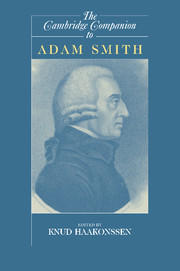Book contents
- Frontmatter
- Introduction: The Coherence of Smith’s Thought
- 1 Imagination: Morals, Science, and Arts
- 2 Adam Smith, Belletrist
- 3 Adam Smith’s Theory of Language
- 4 Smith and Science
- 5 Smith on Ingenuity, Pleasure, and the Imitative Arts
- 6 Sympathy and the Impartial Spectator
- 7 Virtues, Utility, and Rules
- 8 Adam Smith on Justice, Rights, and Law
- 9 Self-Interest and Other Interests
- 10 Adam Smith and History
- 11 Adam Smith’s Politics
- 12 Adam Smith’s Economics
- 13 The Legacy of Adam Smith
- Bibliography
- Index
3 - Adam Smith’s Theory of Language
Published online by Cambridge University Press: 28 August 2006
- Frontmatter
- Introduction: The Coherence of Smith’s Thought
- 1 Imagination: Morals, Science, and Arts
- 2 Adam Smith, Belletrist
- 3 Adam Smith’s Theory of Language
- 4 Smith and Science
- 5 Smith on Ingenuity, Pleasure, and the Imitative Arts
- 6 Sympathy and the Impartial Spectator
- 7 Virtues, Utility, and Rules
- 8 Adam Smith on Justice, Rights, and Law
- 9 Self-Interest and Other Interests
- 10 Adam Smith and History
- 11 Adam Smith’s Politics
- 12 Adam Smith’s Economics
- 13 The Legacy of Adam Smith
- Bibliography
- Index
Summary
Adam Smith's lasting fame certainly does not come from his work on language. He published little on this topic, and he is not usually mentioned in standard histories of linguistics or the philosophy of language. His most elaborate publication on the subject is a 1761 monograph on the origin and development of languages, “Considerations Concerning the First Formation of Languages.” Smith's monograph joins a long list of speculative work on this then fashionable topic (cf. Hewes, 1975, 1996). The fact that he later included it as an appendix to his successful Theory of Moral Sentiments indicates that Smith “set a high value” on this monograph (Stewart, 1793: 32) - an appreciation he did not bestow on his lecture notes on rhetoric and literature, which he consigned to the flames. Although Smith devoted most of his teaching to language-related topics, and certainly developed an organized body of convictions about the subject, it would be an exaggeration to say that he had a “theory of language.” In contrast to Theory of Moral Sentiments, Smith did not call his monograph a “theory,” preferring the modest “considerations.”
- Type
- Chapter
- Information
- The Cambridge Companion to Adam Smith , pp. 79 - 111Publisher: Cambridge University PressPrint publication year: 2006
- 11
- Cited by



